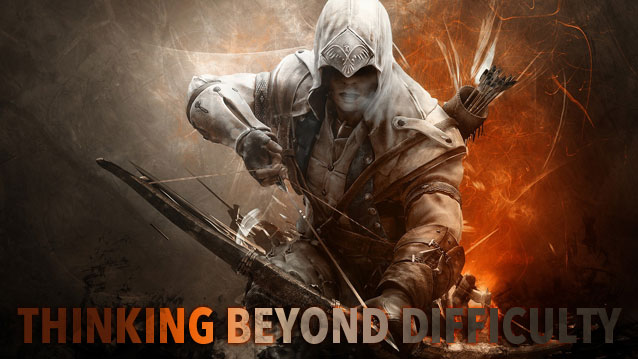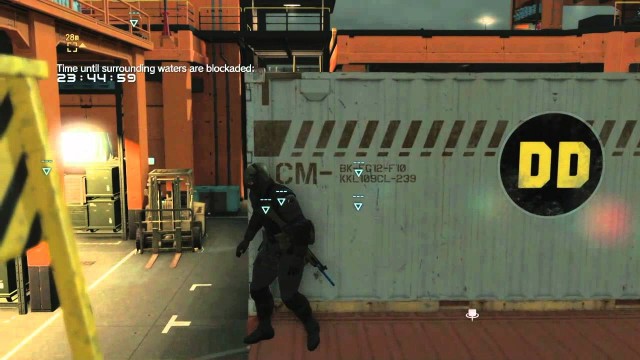

To say the 2000 release of Deus Ex changed the face of gaming might sound hyperbolic if it weren’t true. Warren Spector’s cyberpunk effort followed in the footsteps of his equally worthy System Shock series, smoothly melding the visceral feel of the first person shooter with the character progression and customization elements of role-playing games. At the time, these genres were oil and water, and this successful hybridization set the stage for games like Bioshock and even Modern Warfare. Deus Ex: Human Revolution clearly has a lot to live up to. Fortunately, Eidos Montreal has delivered on all fronts.
Above: El Dorado
Unlike 2003’s unfortunate DX: Invisible War, DX:HR is as unapologetically cerebral as the original, and immediately throws the player into a world in conflict. You play as Adam Jensen head of security at Sarif Industries, a corporation that sells human augmentations (robotic arms, x-ray eyes, and the like). They're on the verge of an incredible breakthrough, when the lab is attacked by mercenaries who kill the company’s leading scientists and leave Adam for dead. Left with no choice, Sarif’s CEO authorizes the use of extensive augmentations to save Adam's life, bringing him back to find out who was responsible for the attacks.
Like its predecessor, a large part of DX:HR’s appeal is in its well written, intelligent story. The Deus Ex franchise has always been a series in the Metal Gear vein, focusing on corrupt shadow governments and corporate espionage, though its main focus is on Transhumanism, the ethical concerns raised when man mixes with machine. You may think a robot arm would be totally badass at first, but when you realize you’ll need an expensive drug for the rest of your life to keep your body from rejecting it, you might be more hesitant. There’s also the more philosophical issue of where humanity ends and machine begins, and how expensive upgrades reinforce the class system. If this all sounds a little highbrow, well, that’s because it is.
Above: Human Revolution is just as filled with conspiracies as the original
Make no mistake, DX:HR relies heavily on its story to compel players forward. It's well written, expertly voice-acted, and presents two sides to every story, letting the player make up their own mind. If you're the kind of player that enjoys reading all of the lore and flavor text (found primarily in emails and e-books scattered around the world), you'll love the level of detail that DX:HR has lavished on everything. That said, players who habitually skip every cutscene and prefer to spend their time fragging noobs will probably find DX:HR to be an excessively wordy slog.
Once augmented, you're given a vast array of upgrade options to choose from. Some directly increase your strength and health while others offer temporary invisibility or an increased ability to hack into computers. While the game can be played as a straight FPS if you upgrade Adam appropriately, the core mechanics slightly favor cover and stealth over the guns-blazing method. Even so, the game is designed to reward every type of approach in its own way; knockouts and kills award experience, but so does finding secret stealth paths to avoid confrontations.
Above: The less subtle approach
DX:HR's gunplay is good, bolstered by fairly intelligent AI that puts pressure on you, but knows when to turtle and flush you out with grenades. If you haven't upgraded any of your combat augmentations though, even the lowliest soldiers will make short work of Adam, especially towards the beginning. Every weapon can be upgraded with faster reload speeds, increased damage and additional ammo capacity though there are rarer weapon-specific upgrades that dramatically increase your firepower. While DX:HR’s boss fights are entirely combat-based, the game does a nice job of providing options for non-combat players, and there's generally a large cache of weapons in the room if you're the type that typically only packs a stun gun.
There are some issues with the combat though. The controls while Adam’s in cover can sometimes be finicky, and it's too easy to accidentally peak out and aim you weapon when you're trying to creep alongside a barrier, alerting enemy guards when you're trying to be stealth. And while enemy AI is solid, they’re easily foiled by hiding in vents, and their inability to use ladders makes escaping too easy in some cases.
An annoying design issue in the quick-access combat menu makes it very easy to accidentally use your health and energy regeneration items. You hold down the Y/Triangle button to bring the menu up, and let go of it after you’ve made your selections, but passing the cursor over any consumable while in the menu automatically highlights it to be used, forcing you to click the left stick to unselect them. It’s much too easy to forget to do this in the heat of battle. The game’s initial difficulty curve is also an issue, as Adam is incredibly weak and will die from a single burst of enemy fire in some cases.
Above: How much liquid can Bounty paper Towels really absorb?
The game is also structured much like the original, punctuating the more objective-driven levels with city hub maps. These city hubs are large areas where the player can explore, investigate, buy items and upgrades, and complete side missions. The side missions deserve special mention as they exhibit the same exceptionally high level of polish as the rest of the game. The writing, voice-acting and subplots in these are rewarding and always worth completing. They also serve a dual purpose of giving you a motivation to explore the expansive cities, it's fun to see hidden back alleys and secret rooftop entrances you never knew existed, but it’s even better when the game rewards you XP and items for wandering.
At one point, we broke into an apartment (purely out of curiosity) and found an overturned chair and a blood splatter on the wall. We hacked into the owner’s computer and read a few e-mails detailing the occupant's participation in anti-government protests and his paranoia that his movements were being tracked. No mission directs you to this apartment, and you could very easily pass over it, but it's this attention to detail and crafting a world that makes exploring and hunting everything down so rewarding.
Above: It's yellow, but it's pretty
While Internet wags have made light of DX:HR's heavy use of yellow/gold lighting, not since Bioshock has a game's visual style been so arresting. Mixing the clean ultramodern look of Mirror's Edge with the grungy cyberpunk future of Blade Runner, the game throws in a little touch of the Baroque period as well. You'll definitely notice the way paisley patterns and rococo furniture contrast with the Apple-styled LIMB clinics. It's a subtle touch, but it reinforces the game’s ideas perfectly, old vs. new, organic vs. inorganic, man vs machine. The synth-heavy, minimalist soundtrack also reeks of the game's high production values.
DX:HR does have a few issues that might turn some gamers off, the most significant being its total lack of multiplayer. While that will undoubtedly alienate some gamers, this is no eight hour campaign, and a single playthrough will take a minimum of 35-40 hours. It’s almost impossible to see everything the game has to offer in a single playthrough though, as there are a huge number of optional paths, content and secrets to explore on a second run, especially if you take a different approach than you did the first time.
Above: The long shots of the cities are amazing.
As far as single-player experiences are concerned, DX:HR is one of the absolute best of this console generation. Unless you insist on having some kind of multiplayer mode, or hate reading, there's no reason you won’t enjoy DX:HR. While it’s slightly more linear than the original, the level of polish and effort that have gone into it more than make up for it. Eidos Montreal has successfully blended the best of both worlds, rebooting a classic franchise without losing the core of what made the original beloved.
Deus Ex? No. DX:HR comes close, but it's slightly more linear, and lacks the revolutionary feel that made the original so unique. FPS/RPG hybrids aren't exactly one of a kind these days. That said, while it may not be better than Deus Ex, coming this close to one of gaming's finest moments is still a huge success.
Deus Ex: Invisible War? Yes. Invisible War was a classic example of the sophomore slump, awkwardly dumbing itself down and alienating a large portion of its original audience in the process. Human Revolution's plot, gameplay and pacing all trump Invisible War's, further solidifying IW as the series' red-headed stepchild.
Mass Effect 2? In terms of gameplay? Yes. In terms of story? No. DX:HR's gameplay is much more diverse and malleable than ME2's, but Mass Effect still has the edge as far as characters, set-pieces, lore and the universe are concerned. Human Revolution has put a lot of effort into its world though, and we're eager to see where it goes from here.
Intelligent, fun, challenging and beautifully realized, DX:HR is an incredibly polished game that lives up to the impossibly high standard of its predecessor.
Aug 22, 2011



